Andrea Macdonald, founder of ideaXme interviews Amy Karle BioArtist. Click the link above to listen, alternatively read the full transcript below to discover why Amy would like to collaborate with an exponential technologist, furthermore her view on the interface between exponential technology and ethics.
Amy Karle BioArtist
Amy Karle is an internationally award-winning BioArtist working at the nexus of where digital, physical and biological systems merge. Karle is also a provocateur and a futurist, opening future visions of how art, science, and technology could be utilized to support and enhance humanity while making advancements in the technology towards those goals in the process of making her artworks. Current projects probe who we could become as a result of our exponential technologies and how interventions could alter the course of our future. Karle has shown work in 54 international exhibitions, including at: The Centre Pompidou, France; The Mori Art Museum, Japan; The Smithsonian, USA; Ars Electronica, Austria; Beijing Media Arts Biennale, China; Centrum Nauki Kopernik, Poland; FILE International Electronic Language Festival, Brazil. Karle is also regularly invited to share her innovations and insights as an expert speaker and in think tanks world-wide. She was honored as one of “BBC’s 100 Women”, has been named one of the “Most Influential Women in 3D Printing”, was Grand Prize Winner of the “YouFab Global Creative Award” and is a Fellow with Salzburg Global Seminar. Karle was also an Artist Diplomat through the U.S. Department of State tasked with diplomacy, social innovation, women’s empowerment, and supporting cross disciplinary collaborations using art and technology to address social issues. Her work speaks to a wide audience as it inspires exploration into what it means to be human and encourages us to contemplate the impacts of technology on our future. The long-term goals of her work are to continue to pioneer in bioart and the art and tech fields and make contributions to the advancement of society, technology and healthcare in the process.
Read ideaXme’s interview with Amy Karle
Andrea Macdonald, Founder, ideaXme: [00:00:00] Welcome, everybody to another episode of the ideaXme show. I’m Andrea Macdonald, the founder of ideaXme. ideaXme is a global network, a podcast available in 40 countries worldwide, a mentor program and creator series. Today marks the beginning of the exponential technology and ethics playlist. Exponential technology is going to change our world in unimaginable ways, most of which will be hopefully positive, but there are risks.
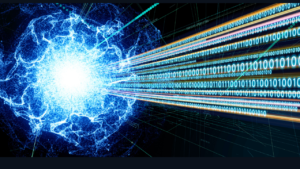
Andrea Macdonald, Founder, ideaXme: [00:00:38] I’m here with a renowned bioartist, futurist and explorer. She uses Art to advance technology and science. She also uses her Art to ask very pertinent questions relating to ethics in the advancement of science and technology. One of the questions she asks is, how do we want to evolve? So let’s find out more. In your words, who are you?
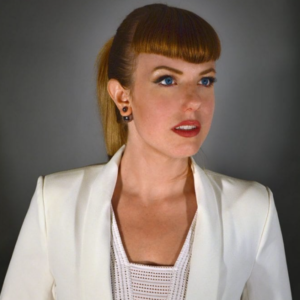
Amy Karle, BioArtist: [00:01:18] Hi, my name is Amy Karle. I am an Artist and I study what it means to be human. I look at what it means to be human now at this time of humans and technology coming together, this dynamic range of who we can become by using our technology: from enlightenment to our ultimate demise. We are at no loss at seeing this in examples in the world.
I specifically look at how this can impact our evolution, how this impacts us and our wellbeing now and going forward into the future. I use exponential technologies as tools in the actual process of making my work; tools like 3D printing, artificial intelligence and machine learning, because these are technologies that when we use them, they have such large repercussion that we can’t undo their effects. I’m asking questions about the impact of these tools while making the Artwork with these tools. In the best case scenario, I can advance the technology towards those goals of positively enhancing us. My work can also open minds to think on a different scale of how we can use our technologies in our everyday lives, in our careers, and into the future in a way that can positively impact us.
Andrea Macdonald, Founder, ideaXme: [00:02:41] Take us through some of your initiatives. They range from working with dinosaurs to working in salt mines in Poland.
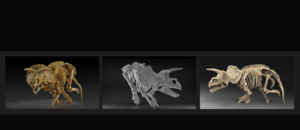
Andrea Macdonald, Founder, ideaXme: [00:02:53] Can you talk us through some of these amazing initiatives which span science, technology, arts and countries of the world?
Amy Karle, BioArtist: [00:03:05] Yes, my work falls under different categories but as technology progresses, these categories merge into one. One of the categories is biofeedback. It involves looking at this internal landscape that we have inside of our bodies and how we can express that in the external world. We have this whole dynamic internal landscape going on inside of us all of the time and scientifically, we can measure what that means, if a heart is beating, if we’re breathing; but there’s all these other realms, too, that we don’t have the tools to measure, like our fleeting emotions, our thoughts or perceptions. This is where the Art really comes into play.
Biofeedback Using A Sandin Image Processor
Amy Karle, BioArtist: [00:03:47] One piece that I’ll point out was when I started working with biofeedback by connecting my body to a vintage Sandin image processor (Sandin IP) that’s behind me here. Over long durations of 5-8 hours, I would lay and meditate while connected to the IP to output imagery and sound. The Artwork was the durational performance, to remind the viewer that we have this dynamic internal landscape and sometimes we have to be quiet to witness it. Then I started getting a lot of people saying: ‘I want to be connected’. So I started working with the more user-friendly brain wave interfaces. Over a period of two weeks, I wore simple neuroheadsets nonstop during waking hours when I was at an artist residency at Experimental Television Center. I never thought of myself as a musical person or musically inclined, but I wanted to be more musically inclined and be considerate of introducing sound into my Artwork. So, with this neural headset, I focused on outputting my brain waves into sound (and imagery as well).
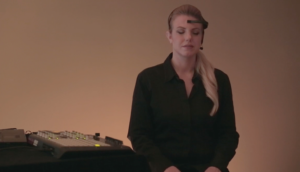
Amy Karle, BioArtist: [00:04:51] Over the course of these two weeks, I started dreaming in sounds. This was interesting because I had never dreamt in sounds before, I would usually dream in color and vivid imagery, but never sounds. Now, I started dreaming in sounds and also hearing sounds differently in the real world. I used my own brain to teach myself to be more musically inclined. This is really interesting.
Amy Karle, BioArtist: [00:05:21] Another area that I work with is sculpture and bioart. When we look at what it means to be human, there’s all these different ways of being human. There is the psychological, the emotional and of course, there’s the biological. So I look at that realm as well.
Amy Karle, BioArtist: [00:05:36] With my bioart, I’m looking at what it means to be human, especially at this time of humans and biotech emerging, how that can influence us. One of the pieces I’m really well known for is Regenerative Reliquary, 2016 https://www.amykarle.com/project/regenerative-reliquary/ and now there is a subsequent piece to that, The Heart of Evolution?, 2019.
Regenerative Reliquary is a piece that is bioprinted. It consists of 3D printed scaffolds for stem cell culture intended to grow into bone. This scaffold can host human stem cells and because of the way that the scaffold is designed, it becomes a lattice or a form that cells can grow onto. With these works I’m questioning the idea of intervention. Usually, these kinds of interventions are made to enhance our bodies and they’re done for medical purposes. As we’re using this technology, we have to consider: Who do we become when we integrate those interventions into us?
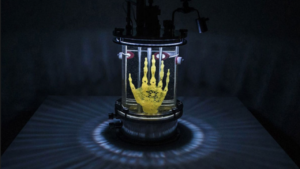
Amy Karle, BioArtist: [00:06:36] When I look at things like a pacemaker, for example, we don’t see somebody in front of us that’s a cyborg, even though they have this highly technological device implanted into them. We see somebody whose life has been saved. This is how I like to use the technology and look at the technology. The truth is that it could be used in many different ways and we have to be conscious of how it will be used because we don’t know how these interventions can alter our bodies.
Amy Karle, BioArtist: [00:07:06] When we start making interventions into our bodies, into our beings, into genetics, we can’t undo that. This is where the exponential growth takes place. I’m really interested in bioprinting because bioprinting holds this promise of possibly being able to extend the human lifespan. Modern medicine has done a great job of keeping us alive to a whole human lifespan, to like 70 years, in some cases 100 years, and having a good quality of life while we are living, but it hasn’t been able to extend an actual human lifespan. I feel that bioprinting may be very disruptive in this way. It is a disruptive technology because maybe we can actually extend our lifespans if we can have replacement parts and replacement organs. At a certain point, this would not just be for those who need transplants for medical purposes: as we age, perhaps we could switch out our organs and therefore live a longer life. We don’t know that answer yet. We don’t know if switching out our parts would allow us to live a longer life but it’s exciting to explore that potential.
Amy Karle, BioArtist: [00:08:17] When we start to think about the next step then, we think about who would be able to access such enhancements / interventions / transplants. In America, for example, it would probably be available for those who are wealthy. In Asia it might be those who are deemed worthy, who contribute most to society. Different countries would have different approaches and laws to who would be able to access these kinds of implants or replacement parts. That opens up so many issues into ethics of access and equity, and also opens up the question of rights to life and rights to death.
Amy Karle, BioArtist: [00:09:01] Even though we’re not at that point yet, it’s important that we start asking these questions and we try to look at the range of how our technologies and biotechnologies could impact us, impact humanity, impact our planet, our environment and impact us over the very long term. Then we can start to have that awareness and build it into our technologies by thinking about who we want to become.
Andrea Macdonald, Founder, ideaXme: [00:09:25] In exploring the future of all living things, you also look at the history of all living things and evolution. Could you talk a little bit more about how your Art brings that to life?
Amy Karle, BioArtist: [00:09:42] Yes, thank you. I look at evolution in a scientific sense, but there’s also personal evolution and this is integrated into my work as well. We all have these personal stories that we carry, and they help us to evolve into the people that we become. We have choices along that path, to help us grow or to hinder or debilitate us. I also look at the big picture of evolution in this way as well, especially when we’re using biotechnology and other exponential technologies to alter the course of that future.
Amy Karle, BioArtist: [00:10:21] One of the pieces that I’m currently working on is The Heart of Evolution?, 2019. This is a biomechanical piece that I eventually would like to work on bioprinting in Cardiomyocytes. I am looking at the heart as both the opportunity for implant design and studying how this is a vital organ that has some design flaws: if we have a blockage, we can have a heart attack and die. I worked with cardiac surgeons to figure out how I can propose a better vascular network design. Also, scientifically, the vasculature is very exciting because if we can bioprint vasculature, we can start to deliver nutrients to organs, so we’re that much closer to actually bioprinting viable organs.
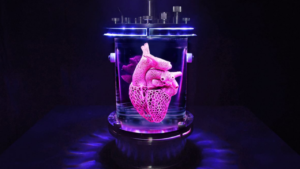
Amy Karle, BioArtist: [00:11:10] There’s a very scientific side to it. As an Artist, I am asking if we were to be successful with this and be able to make new implants that nature never intended, how does this alter us? The heart is known as the emotional seat of consciousness. The place that we feel love, joy, sadness, and all of these emotions. If we’re going to replace it, who do we become as a person and as a species because of that?
There’s so much we don’t know about how all of this works. We don’t know what makes us alive. We’ve been asking this fundamental question across many fields for thousands of years, maybe even longer and we just don’t know those answers. So, as we’re playing with this, we have to be conscious that we don’t know what we’re doing… and this is where a lot of the ethics and ethical questions do come into play. I’m asking these questions through making the Artwork, actually using the tools and technologies that may be used to actually create such replacement parts.
Exponential Technology and Ethics
Andrea Macdonald, Founder, ideaXme: [00:12:19] Have you haven’t been invited onto a board or into a group or institution where they are looking at the ethical considerations of exponential technology? It just strikes me that with your broad experience as an Artist, futurist, almost a technologist yourself, you certainly would have a place within a group exploring the ethical considerations.
Amy Karle, BioArtist: [00:12:52] I have not been formally invited to be a board member, but I am often invited to give talks and work with tech companies to make Artwork using their tools and technologies, and ask these fundamental and ethical questions in the process.
Many of my Artworks can be seen as artifacts of a speculative future. I’m thinking about who we could become as we use and merge with our technologies, and I’m using the actual technology in that process of making the work. My hope and what often happens is that I’m moving some part of that process, that workflow, or that technology forward to accomplish those goals in the process of making my Artwork and collaborating with companies, institutions and other fields.
Amy Karle, BioArtist: [00:13:33] As an Artist, I’m also a provocateur. Having these tough conversations can often be done by an artist or a philosopher. Working together triggers these conversations, insights and innovations.
Amy Karle, BioArtist: [00:14:01] When you collaborate together and ask each other these questions, we find that a lot of us are trying to ask these same big questions of: Who are we? Why are we here? How do we create a better world? This is an important way that we work together. There can be and is often technical and scientific developments made in the process of working together, it is the ways that we open each other’s minds to think on a different scale that makes a long-lasting impact. Even though I’m not specifically on any boards, I’m often invited to give talks and partner with companies or make my Artwork using their technology to be able to work through these kinds of questions together.
Andrea Macdonald, Founder, ideaXme: [00:14:30] ideaXme’s audience is quite a mixed bag. We have an audience of creators who shape our world and university students who would like to impact our world. There’s also the broad public who are interested and curious about what’s happening next. Could you talk a little bit about exponential technology? What is it and what are the different components?
Amy Karle, BioArtist: [00:15:03] Exponential Technologies are the kinds of technologies that make such a broad impact that we can’t undo their effects. They’re impact does not occur in a linear fashion, it continues to advance exponentially. It’s technologies that when we put them into place, they have huge growth. We can look at our social media platforms in that way, which are giant social experiments using our technology and working with humanity. We can see the range through that: from the benefits of being able to connect to the world, to work collaboratively across the world and education, but also the dangers as well. We see what happened in the United States, that the use of social media platforms influenced our elections, impacted our national security, and our personal safety on so many levels. We can see how this kind of technology is exponential. We think of exponential technology when people talk about A.I. being able to take over and machine learning that can go down a path where we can’t stop it. This is the idea of exponential technology.
Amy Karle, BioArtist: [00:16:06] We also look at exponential technology in our biotechnologies as well for example when we start to modify food crops and then that genetic code can’t be undone. We have to be very mindful when we are using our exponential technologies by understanding the repercussions and that this reproduces down a really vast scale. Oftentimes we can’t undo it.
Amy Karle, BioArtist: [00:16:32] Also, we have to consider this exponential impact with human modification as well. Now we can select our offspring, for example. This often is done because we want to down select out a really terrible genetic disease, but people can also select the sex of their child. I was born with a life-threatening birth defect and I feel like my parents would have, if they had that option, selected for me not to have that because it was very traumatic for them, and it was traumatic for me. However, that life experience made me who I am today. So, I question how making these selections will alter us fundamentally, physically and emotionally.
Invitation To A Top Exponential Technologist
Andrea Macdonald, Founder, ideaXme: [00:17:20] Talking now to the experts in our audience, Amy. You’re interested in collaborating with an exponential technologist within health. Could you talk a little bit about that and how you envisage working with the technologist in these areas?
Amy Karle, BioArtist: [00:17:41] Yeah, specifically right now, what I’m looking for is any companies, institutions or groups that are interested in doing research and working with machine learning in 3D. The reason that I’m interested in this is because when I work with digital into physical, this is computer 3D into real world 3D. One example is with bioprinting, this is in 3D. It is closer to how our bodies are made, the inside of our bodies are 3D. When we look at all the forces that are put upon our body, it doesn’t just happen flat in a petri dish. I want to explore working with machine learning in 3D further (deep learning and computer vision included) which is extremely important as the digital and physical continues to merge… think: bioengineering, generative engineering, generative design and fabrication, autonomous robots and self-driving vehicles, factories of the future… the list goes on.
Amy Karle, BioArtist: [00:18:18] What I would ultimately like to do is to create an entire integrated system where we can use big data and AI to analyze where patients have deformity or disease, then use generative engineering CAD to propose a new design and bioprint a replacement part. In the example of the heart, a doctor can take a scan of a patient’s heart and then compare it to the big data of 10,000 or 100,000 healthy heart scans. A computer would help identify where there is a deformity or disease in addition to the experts looking at these scans. Next, a generative design or generative engineering program could propose a replacement design and then use a patient’s own genetic material to bioprint that part. After the necessary growing time, it could be put back into the body with robotic assisted surgery. Then, maybe even have a whole system with personalized medicine afterwards by having a 3D printer that would print out medicines on the patient’s counter at home to support their system with whatever is needed that day.
Amy Karle, BioArtist: [00:19:18] I have been working on this. My body of work: The Body and Technology, a Conversational Metamorphosis, 2017 are depictions of this process. https://www.amykarle.com/project/the-body-and-technology/
I worked with the CAD programs, a bit of evolutionary machine learning, and artificial neural networking (ANN) to design these parts… but we need to work on the machine learning in 3D. I’m traditionally trained as a sculptor so 3D is an area that I feel very comfortable with.
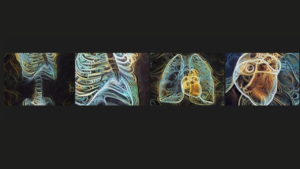
Amy Karle, BioArtist: [00:19:41] I did start exploring this with the recent project that I did with the Smithsonian in 2020 where I was looking at deep time. They gave me the data from dinosaur fossil scans to work with and I thought, what am I going to do with these dinosaurs? I was thinking about how can we look at evolution from the past and then into the future, across evolution and technology. I was designing, with a kind of AI tension mechanism and evolutionary machine learning, different places that we can stop on a path of predicting how we could potentially evolve in the future from this knowledge of this extinct species x exponential technology. That’s a complicated project and it’s another conversation but this is similar to some of the ideas that I’m working with and want to continue to pursue with machine learning in 3D. The applications are increasingly important and necessary across many fields as we merge the physical with the digital.
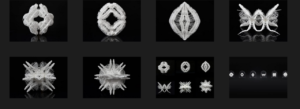
Andrea Macdonald, Founder, ideaXme: [00:20:26] Could you talk to us a little bit about your human story and how you reached this point in life with this incredible career. You started, in terms of university education, with the objective of being a scientist, I believe. Could you talk a little bit about your own life, the point and at which you decided to specialize in philosophy and Art? Later, please talk to us about the role that rich connections have played and continue to play in the way that you evolve as an Artist.
Childhood Illness
Amy Karle, BioArtist: [00:21:05] My journey began from my birth. For so many of us, our life stories inform what we do and everything that we do. I was born with Aplasia cutis congenita. I was missing a very large amount of skin and bone on the top of my head. Now, we know more about this disease and more children live with it because they have smaller regions that close up, but I had a really challenging case.
Amy Karle, BioArtist: [00:21:33] Growing up, I couldn’t do what other kids did and I had to be very protected. In fact, when I was really young, the doctors thought I may have to live in a bubble. My parents were a pharmacist and a biochemist, so they took really good care of me and also had knowledge of the industry to be able to know how to find and reach out to different doctors that were doing cutting edge work. (It was before we had the Internet as we know it now).
Amy Karle, BioArtist: [00:22:01] Growing up, I had an openness to try what could work with the medical experts and an interest in medical futuring because I just wanted to heal my body and be like the other kids. At the same time, I had to develop this understanding of the human condition because of the body. These are things that a lot of people don’t have to come to terms with until they’re much older. I was dealing with this fine balance of life and death. Also, I grew up in an Italian American community where my grandmother helped raise me and we would visit her friends when they were old, sick, and dying, and I had many family members die too throughout my childhood. I would go to their funerals and partake in all of the rituals surrounding death. So I had this questioning of the physical body, some spiritual aspect, and the human condition… This all informed me from a young age.
Amy Karle, BioArtist: [00:23:09] I got into Art because I feel like Art is the language that I communicate through the best. Since I was a young child, I was interested in the body as one of the greatest pieces of Artworks ever made.
Growing Up In The Home Of IBM
Amy Karle, BioArtist: [00:23:35] I grew up in the home of IBM, and that influenced me as well. When I was a kid, we would go on field trips and see these giant rooms that were filled with computers,. We were told this story about how when we were the age that I am now (40) that computers would be able to do everything for us and that we would be able to live lives of leisure, do charity work, and pursue the arts. It was a very romantic picture that was painted for us. I see now that we have achieved that computing power, but we don’t often use it in that way. We see how we are actually using it to our disadvantage, how we’re run down, overloaded, and overworked.
Amy Karle, BioArtist: [00:24:18] I also lived in Detroit for a decade and there – when you read the old texts about the Industrial Revolution, they read like we could be reading it now. They talk about these machines that are made to empower us, but then end up enslaving us. So all of this had a big influence on my approach and my mindset as I still have this romantic hope that we should design and think about how we can use our technologies for good, and to improve our lives and improve the world around us.
Amy Karle, BioArtist: [00:24:58] Another big influence is that my parents were scientists, a pharmacist and a biochemist, and I grew up assisting my mom in the lab. So, working in the scientific world was very comfortable for me just by being in that environment. I assisted my mom in the lab a lot doing gel staining, pipetting, that kind of thing. I would help her grad students with their experiments. I was exposed to the scientific environment and comfortable working in that environment but I feel that the way that I express myself the best is through Art. I could create something that in one moment, someone can walk by for one to three seconds in a museum and be able to just understand all of these thoughts and emotions and feelings and personal stories and big picture ideas and science and technology, all of what goes into it, in one instant. They can feel that as they walk by the Artwork.
Rich Connectedness
Andrea Macdonald, Founder, ideaXme: [00:26:10] What about rich connection? What role has rich connectedness played in your life?
Andrea Macdonald, Founder, ideaXme: [00:26:17] The reason I ask that is because ideaXme has found this correlation right the way through all the interviews and research that we have done in looking at the people who shape our world, that there is this rich connectedness, individual to individual. A spark happens and way down the line, many people can benefit from that spark.
Amy Karle, BioArtist: [00:26:47] There’s many different kinds of rich interpersonal connections, there’s professional interconnections that help to advance what we do, inspire us, and spark innovations. Then there’s also these personal stories that so deeply influence us and shape who we are. Those are from our own life experiences and the rich personal connections that we have with ourselves, our families, and our friends.
Amy Karle, BioArtist: [00:27:14] In this context, I think about my close friend Lisa a lot when I’m creating my bioartwork. Lisa had pulmonary hypertension, which is a terminal illness of the lungs, and she was sick for 10 years before she had a double lung transplant. She was an ideal candidate for the idea of being able to bioprint a replacement part (lung) because she was sick for a long time, so there was the time to develop, print and grow a replacement for her. Lisa really inspired me through a lot of this journey. There is the physical need of something that I would have done if I could ultimately provide something that would heal her, and there was the emotional side as well. I watched her develop so much grace. Through this disease, she embraced it as an opportunity to develop her strength of person and I’m very honored to be able to see her on that journey.
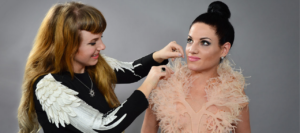
Amy Karle, Bioartist: [00:28:16] When she was in the transplant house recovering from surgery, not only did her and I have a lot of conversations about her experience, but I also had conversations with other people there that received transplants as well. No matter what their background was or their religious affiliation, they all told me a similar story of feeling so different after they got a transplant, like they had part of someone else in them. They felt like they were a different person in some way. I heard this from so many people. This influenced my work as well.
This is where the power of the Artwork is, where I can take these very medical, scientific and technological processes, but also integrate all these other thoughts, emotions and stories, and all these other influences that I have in my world and share these stories with others. Even though they’re very personal, they also connect to the human condition and the human spirit and I feel come through the artwork in that more universal way of understanding and empathy for the human experience.
Amy Karle, BioArtist: [00:29:17] Almost everybody, no matter what our background is – or social status, or economic status, or sexual preference – we all have a point in our life when we have to deal with this kind of pain and suffering from living through the body. This is something that we can all fundamentally find a relationship to with each other. We’re all in a world now, most of us at least, where we’re using technology and it is impacting us. It is impacting our health and our well-being. We have conscious choices of how we think about it and how we want to use it. We have the opportunity to use it to become better people. I try to focus on how we can use technology to advance the human story and advance the human condition in a positive way now and in the future.
Amy Karle, Bioartist: [00:30:07] In all of my Artwork, I have to collaborate with other people, and I love doing that. It’s a joy to do that. With my work, when you look at it, you can kind of see that I need to work with scientists and that I need to work with technologists just in order to create it. What happens in that process is the creativity and that spark that you’re talking about, that happens in-between people when we have that rich connection of working together. This is the really amazing part. This is what makes the work so joyful. What makes you excited to go to work and pursue the work. To stay up late and jump out of bed to work on it. It makes it intellectually stimulating and it does form those deep bonds amongst other people. It’s another level of connectedness. I like that you call it rich connectedness. I’ve never really heard that term before, but that’s the truth of what it is.
Amy Karle, BioArtist: [00:30:55] When I go into working on projects, it’s usually that I have a general concept or a loose idea of what I would like to pursue. Then I put it out there, if I have a talk or something, and I say this is what I’m working on, and people come to me or I’m introduced to people, and then we start brainstorming together, and this is when the real magic happens. What can each of us bring to this project that is unique to us? What is our specific talent and skillset? There’s a celebration in a way of saying: what are you good at, what am I good at? When we work together and we have that intense focus on the project, the project will take over and new things manifest in that process and we learn so much in that process. I feel very thankful to have so many rich connections through almost every project that I do.
Amy Karle, Bioartist: [00:31:50] The collaborations take different forms. Sometimes it’s very intimate, working together every day or I go into a company and work with their team on site. Other times it’s more independent, especially now during the pandemic where I’m sent data and information and we work remotely. It’s this process of bringing people together that is so exciting.
Amy Karle, BioArtist: [00:32:13] For example, I’m thinking of a specific time when I was working on the scaffold for Regenerative Reliquary. This was an extremely complex and difficult project. I held a meeting and said, this is where we’re at right now, this is what I’m working on, these are is the struggles and the problems and challenges. I was having problems with materials timing out because the 3D print took so long to create that part of the materials would evaporate and that would change consistency of the print media. So we had to develop new materials for the process as it has to be so precise for cells to be able to grow on it. This was a big technical challenge. I brought together the technologists, material scientists, and the bionano scientists and then I proposed this problem. Then they went off to the whiteboard and seeing them working together was so inspiring to me, but they were the ones that made the real developments that day. They made the best formula of PEGDA hydrogel that I had ever used. It was the most successful formula for the project. They ended up making innovations and developments for their specific fields as well, even though it was inspired by the Artwork.
Amy Karle, BioArtist: [00:33:23] They took their talents and they made it into what we needed to make the project successful. It was interesting because as an Artist, I wanted something that was human scale and that was uniquely and quickly recognizable as human. The bones that are most recognized in humans are skulls and hands. So that’s why I chose a hand design. Scientists usually do this work on a very small scale in the lab at a few millimeters or less; but as an Artist, I wanted this human sized object. So this size requirement of the artwork is what actually pushed us to develop new materials, to develop the technology, the tools and workflows, to be able to get something that large into 3D printed form. To date, this is still the largest known 3D printed scaffold for cell culture that’s known to be made. It took us all working together to make those advancements.
Amy Karle, BioArtist: [00:34:20] That points to some of the technical things that we can measure, but it’s really the human connection that drove that forward. The desire to work together and the excitement that comes from inventing something new, creating something new and innovating. Then with the Artwork, it is so satisfying because we can actually see it in a museum after, whereas scientists and technologists often do the work in a lab and not a lot of people get to see it. It doesn’t tell the same story or have the emotional impact. They might even publish a really acclaimed white paper, but the general public doesn’t have the opportunity to see what goes into that. In this way, the Artwork not only tells personal stories behind it, but it also tells these stories about the collaboration and all the different elements that go into it of us working together.
Amy Karle, BioArtist: [00:35:06] In this case, new material formulas were made and like I mentioned, this is the largest known 3D printed scaffold to be made for stem cell culture that we know of.
Andrea Macdonald, Founder, ideaXme: [00:35:19] Which out of all the work that you have done to date, are you most proud of and why?
Amy Karle, BioArtist: [00:35:27] That’s a really hard question. I honestly feel like what I’m most proud of is that I keep working. It’s not necessarily a specific work, it’s that I keep working and I keep growing. This is what I encourage other people as well to do in any field. Keep going, keep going, keep going. I have some master works that I’ve made, a few that I mentioned here today. As I keep working, it’s really a surprise what is created. The next piece seems better than the last, but at the same time, when I make the current piece or the next piece, I always just want to make the next piece because then I’m inspired, or I learn something new in the process. Some new artifact appears that I want to explore further. Honestly, I don’t mean to evade the question, but I feel the most pride in continuing to work, continuing to feel that drive to work and the passion to work. Also, on the days that I don’t feel that, to keep working and then it comes in the process.
Andrea Macdonald, Founder, ideaXme: [00:36:34] Amy Karle, it’s been an absolute pleasure talking to you. Thank you very much indeed. Before we go, could you please give us your contact details for the exponential technologists wishing to collaborate with you?
Amy Karle, BioArtist: [00:36:49] Yes, you can contact me through my website www.amykarle.com Also, if you’re connected with the ideaXme network, you can connect with me through Andrea [email protected].
Amy Karle, BioArtist: [00:37:03] Thank you very much for having me today. I really appreciate our conversation. I can’t believe it’s over already.
Credit: Andrea Macdonald, founder ideaXme.
Amy Karle’s website
Follow on Twitter:
ideaXme @ideaxm
Follow on: Instagram:
ideaXme @ideaxme
Credits: Andrea Macdonald, founder ideaXme
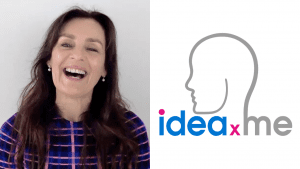
Find ideaXme across the internet including on iTunes, SoundCloud, Radio Public, TuneIn Radio, I Heart Radio, YouTube, Vimeo, Google Podcasts, Spotify and more.
ideaXme is a global podcast, creator series and mentor programme. Our mission: Move the human story forward!™ ideaXme Ltd.
If you enjoyed this interview, please check out our interview with Professor Winfried Hensinger head of the Sussex Ion Quantum Technology Group and director of the Sussex Centre for Quantum Technologies.


Pingback: Architecture for Outer Space - ideaXme
Pingback: Adam Rogers, WIRED magazine: How The Science Of Colour Made Us Modern - ideaXme